MiGs, Stars & Magic Books: A Brief History of Trespassing in Moscow
An illustrated guide to urban exploration in the Russian capital.

31 January 2014
Sometimes people ask me what was the most stupid thing I’ve ever done. I don’t normally think long when answering, instead simply blurting out, “Maze Drain.”
It’s not that this Australian drain was all so very dangerous; in fact, most of the network was a lot of fun to explore. Other parts, however, were not. This is a story I’ve been meaning to tell for a long time, and, by way of a disclaimer, it’s not going to make me popular with either claustrophobic nor arachnophobic readers.
Make sure you’re sitting comfortably, as I have a feeling this one is going to be a long post – it was, after all, a hell of a long drain.

The large, interconnected system of culverts, drains, overflow chambers and maintenance tunnels commonly referred to as the ‘Maze Drain,’ may not be Melbourne’s longest drainage network; but it is perhaps the hardest and most confusing to navigate. The clue here is in the name.

While touring Melbourne I was lucky enough to receive a tip on the Maze Drain, a popular site which the local chapter of the Cave Clan often use for their initiations. From what I understood, the Clan have a sort of annual ‘open day’ – an occasion which sees potential new recruits led on an expedition through the twisting turns of the Maze in order to test their mettle… and, perhaps, to root out the claustrophobes.
Large portions of the drain are easy to access, provided you know where to look. For the most part these are large, spacious tunnels, dry in the summer and daubed in the colourful graffiti left by the many explorers who have trodden these routes before.
As it would turn out however, these rookie-friendly regions of the drain only account for one limited portion of the total network. At the other end of the drain, far upstream from the ‘club house’ and from the large and dramatic outflows that spill into the River Yarra, the Maze Drain really does live up to its name. In these less-explored regions, the absence of graffiti tells a different story… and the narrow crawlspaces are thick with the undisturbed webs of poisonous spiders.
I was wrong in assuming that Maze Drain would be easy.
I was wrong in guessing that it would be safe.
I like to think I’m not a complete idiot; I wouldn’t, for example, have ever considered tackling a drain like this one on my own. Instead I took to online forums, posting cryptic messages about “adventures,” “maps,” and “hidden treasure.”
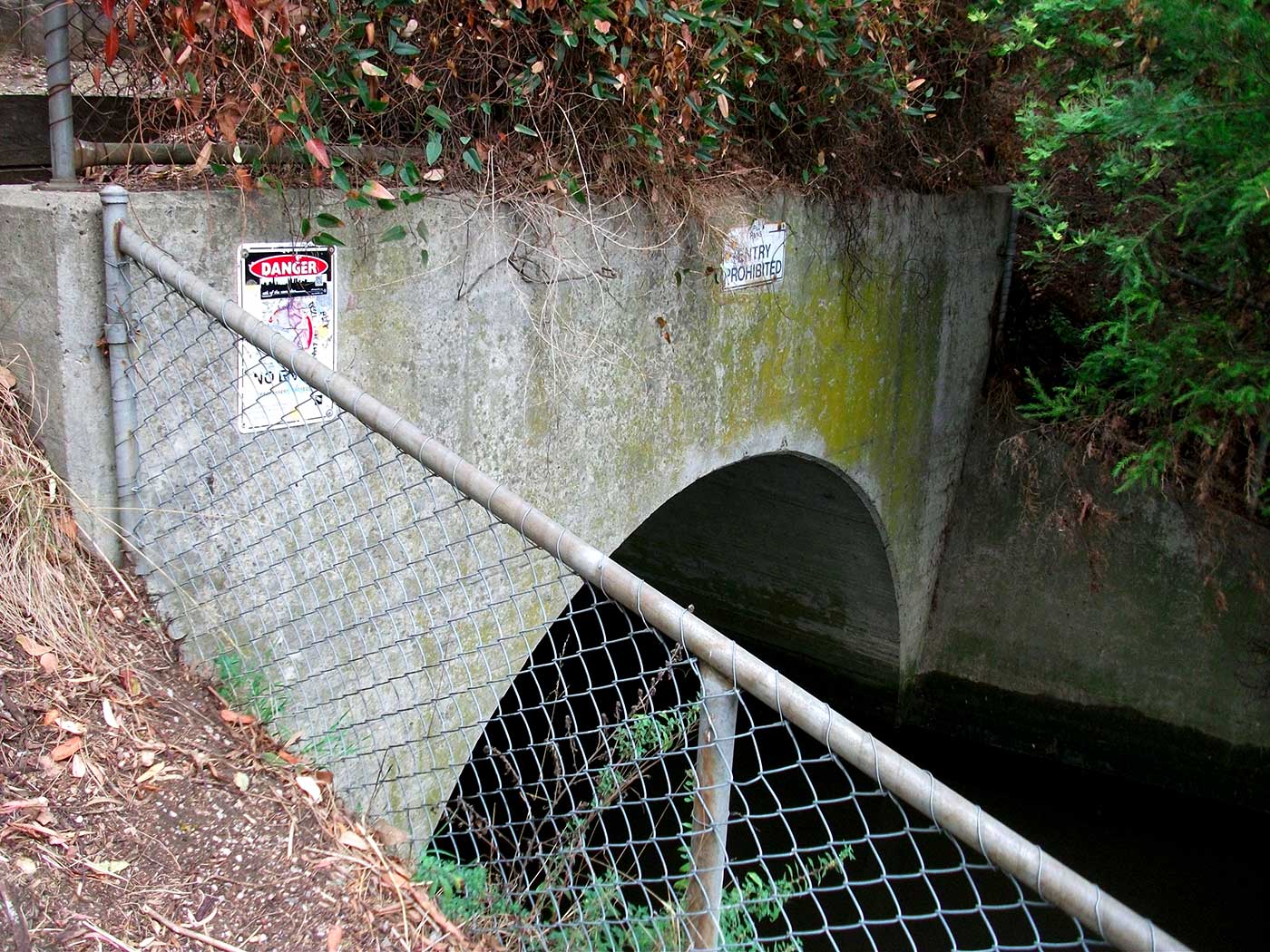
A reply came back almost immediately from a Swedish backpacker who was passing through Melbourne, and we made plans to meet at a train station near the outflow pipe. He warned me he’d be tall, and I certainly had no problem spotting him.
Following a map that I’d scribbled quickly onto the back of a napkin, we headed through a park and down towards the river. Here we found the outflow easily enough, a cavernous opening that poured out into the Yarra. “Danger,” read one sign, another: “Entry Prohibited.”
As I’ve mentioned in another post about exploring Australian drains, the official penalty for trespassing in these subterranean waterways is billed at $20,000. An insanely high figure, that seems to be cited as a deterrent but rarely exacted. Nevertheless, neither of us had any intention of getting caught in the act – and to enter the drain here, by its downstream outflow would have involved wading slowly in through chest-high water, and in full view of the cars and pedestrians on the far bank.
It wasn’t an appealing prospect, and so I consulted my map once more… then, heading back to the train station, we went on a hunt for a more discrete entrance some place upstream.
It was another five stops on the metro to the point on my map marked as ‘Upstream Entrance.’ This wasn’t the only other access that I had marked on my clumsy drawing of the drain network, though: I had marked a couple of possible manhole openings, as well as the ‘Park Entrance’ situated roughly three quarters of the way from the upstream culvert to the outflow on the Yarra.
However, this first entrance looked as though it would give us a nice run of the place – a meandering stretch of roughly 5km in total, and a chance to explore a good long length of tunnels.
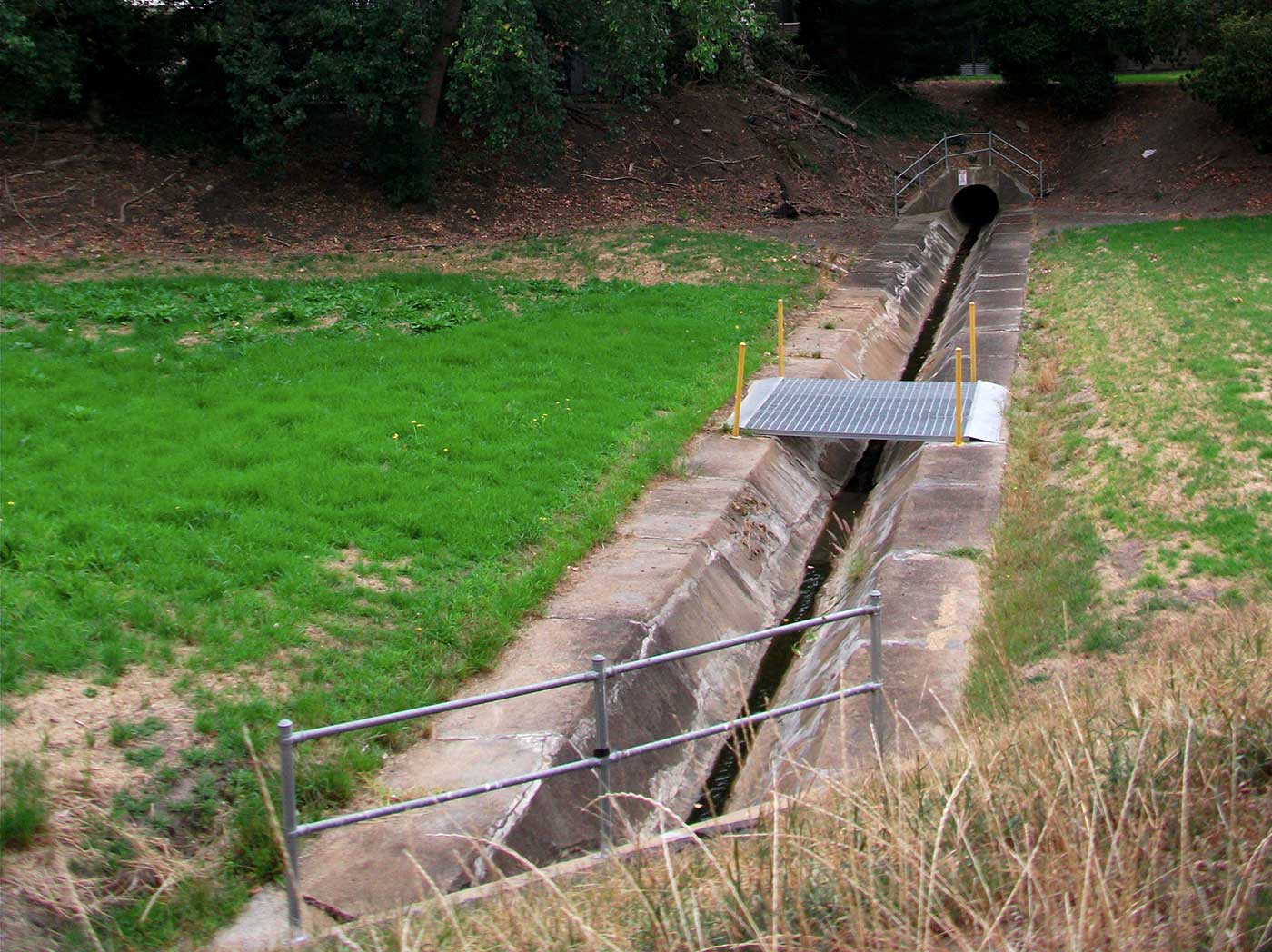
We found the culvert easily enough. A long, shallow gulley ran the length of an enclosed area beside a grassy playing field. The area was fenced off, a high perimeter that separated the opening from the park. A jogger passed us as she circled the running track. A little way off, a man was walking his dog. It would have to be a quick climb.
Hopping up on a nearby garden wall, my tall new friend had little trouble hoisting himself up and over the fence. I followed – half vaulting, half falling – into the sunken enclosure beyond.
I didn’t know if anyone had seen us enter, and I didn’t stop to look back. There was no turning around now, and once inside the drain it was a safe bet that we wouldn’t be followed. I made a dash for the culvert on the downstream end of the concrete gulley, dropping to my hands and knees as I entered the small opening. While the Swede’s height had served him well in crossing the fence, now it turned against him as we both squeezed into the dark, narrow tube. Soon enough though, we were following a slimy trickle of water that led a slow, ponderous route in the direction of the Yarra mouth somewhere downstream.

I flicked on my headlamp, to reveal a bare grey tube of concrete that disappeared off into the darkness ahead. While my map had offered vague lines joining one entrance to the next, it failed to provide details as to the nature of the drains… it gave us no way of guessing how long this concrete cylinder would continue, before we’d be able to sit up, get off our hands and knees.
We hadn’t travelled far before I began to notice the cobwebs. This being high summer in Australia, the walls of the tunnel were dusty and dry, lined with webs that caught in my hair as I brushed past. As I crawled I tried to wave my hands in the darkness ahead, clearing a path through the sticky strands. That took care of most of them, but still the odd thread would catch on my face, my ears, my eyebrows.
The architects themselves were mostly hiding in the fine cracks which lined the concrete shaft – I’d make out movements on the walls, shiny black bodies creeping at the corners of my vision before squeezing themselves into tiny fissures in the hard surface.
It wasn’t until we’d covered what felt like a mile, my palms and knees already sore and aching, before I saw one of these spiders close up: turning briefly to glance behind, I spotted it on the wall beside me. It was only small, perhaps a centimetre in length, but as it span down on a web no more than a foot away from my face, I suddenly recognised the round, black abdomen, the thick crimson stripe that ran down its body.
I panicked, springing back as far away from the spider as the confined space would allow; perhaps an extra foot. As I did so I span the torch beam around the tunnel walls and now, peering more closely into the gloom, into the cracks that surrounded us, I made out more of the same black and red bodies, countless small, shiny spiders creeping and hiding all about us. Redbacks. Dozens and dozens of redbacks.

A quick note on the redback, for those not familiar with this infamous spider. The redback (Latrodectus hasseltii, if you want to get technical) is a member of the widow family, the more aggressive females marked with a thick red stripe along their abdomen. As far as humans are concerned, these are some of the most dangerous spiders around; generally ranked something like the fifth most venomous species in the world. Their neurotoxic venom can typically cause nausea, vomiting, intense pain and swelling around the wound which eventually spreads into the whole limb. Thanks to the widespread availability of an antivenom serum since 1956, there have been very few recent cases of human death linked to a bite from a redback.
However… that’s just one bite. The more I looked, the more redbacks I was spotting; and we were a long way from any antivenom now.
Far up ahead, it looked as though the tunnel was coming to an end. Either we pushed on – fast – or we’d have to crawl back out of the narrow, spider-infested tunnel, a long way back and completely in reverse.
My companion caught up with me, asking why I’d stopped.
“Don’t, uh…” I stammered, “whatever you do, don’t touch the walls.“
I pointed out one of these spiders to him, close up and under torchlight.
“Shit,” he said.
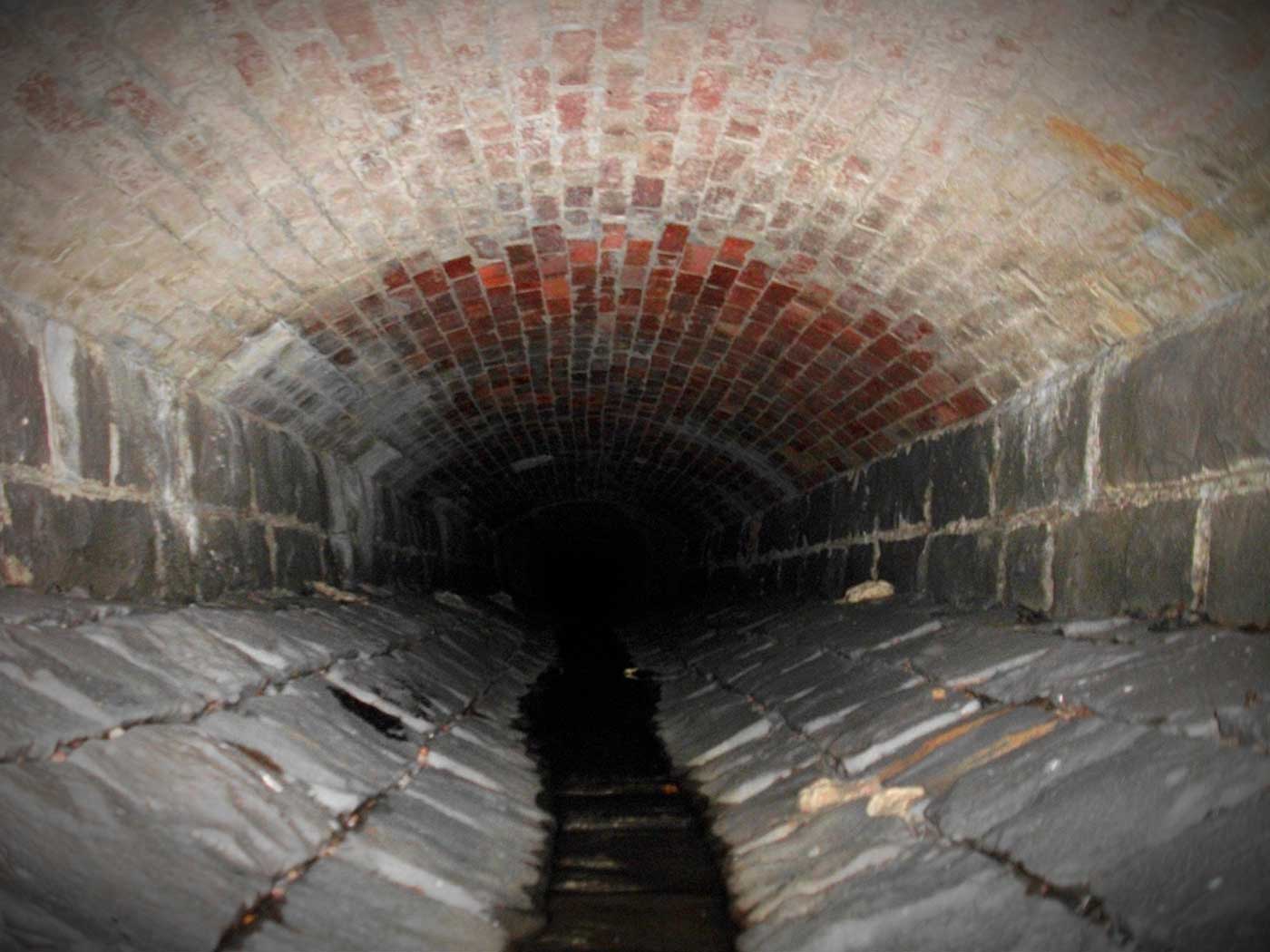
Any regular readers of this blog will probably have gathered that I’m a big fan of spiders – almost to the point of obsession. I can safely say, however, that on this occasion I felt no love for them.
I took a water bottle out from the side pocket of my bag, brushing it free of trailing webs: any time something moved, I smashed it with the plastic bottle. Web, spider, even my own shadow, I hobbled along on one hand and two knees through the mucky water, swinging my plastic club at even the slightest hint of movement.
High on adrenaline, I scraped my knees bloody as I dragged myself onwards through the darkness. I ignored the pain though, pushing on through until the concrete tube turned, twisting around to open, at last, into a tall brick chamber. We scrambled out into a junction, where fresh water rushed past us from some place upstream.
Panting and leaning against a wall, I shone the headlamp over myself… to find first one redback on me, then a second and a third. I swatted at them madly with the bottle, jumping and shaking as I knocked them loose and into the water.

The adrenaline began to wear off, and that’s when I noticed the pain in my hand. It looked like a bruise at first, a faint reddish-purple mark spreading out around a small swelling on my right index finger. It was beginning to hurt like hell.
I make a habit of never going anywhere without my Swiss Army penknife; so, rummaging about in my backpack I pulled out the blade, prodding and poking at the wound to spill the venom out. In the darkness of the drain however, I had no idea what I was doing. So much for surgical precision; in the end I hacked and sliced at my finger until it bled, and then washed it out in the rushing waters of the drain.
We looked at each other then, both shaken and a little bit terrified by what we’d let ourselves in for. There were two ways we could go from here. The first was back: crawl through the long length of that tiny tube again, this time knowing full well that we were entering a nest of aggressive, venomous spiders.
Alternatively, we could push on towards the river… we now had a moving stream to guide us, and hopefully, the tunnels would only get larger and more spacious from here on.
Rather than returning my knife to my bag I slipped it into my pocket instead, raised my plastic club in readiness, and stepped onwards into the next section of tunnels.
From here on – thankfully – the tunnel opened up a little. We still had to duck to avoid the low ceiling, the trailing spider webs, but at least this new and curiously shaped passage allowed us to move that much faster.

In time the oval drain spilled out into a wide chamber, a low ceiling hanging over a central gully; dark, brick cobbles angling down to channel the stream at its centre. The additional space came as a relief – we even rested for a moment, sat on the damp stones as we rehydrated.
We’d gotten used to the spiders now, common as they were, and pointing them out had become more of a game than anything else. My finger still throbbed, and a faint purple blush had spread past the knuckle to my hand – rather than a pain though, the whole area simply felt numb, uncomfortable, and for the most part I was able to ignore the sensation.
As we moved on through this low chamber we were forced to squat, crawl through the stream, ducking low to avoid the webs that trailed like tendrils from above.
I lose track of how far we travelled that day. We saw so many different types of tunnel across the length of the Maze Drain, passed through so many intersections and junctions, that I struggle to remember the order they came in. I think there was a large, circular passage that we entered around this point – a tube of red bricks which allowed us to accelerate our pace for a while, before finally leading back into another wide and angled chamber much like the one before.
One thing I do remember, however, is that it was somewhere around this point I saw what I believe to have been a funnelweb.
Funnelweb spiders are pretty unpleasant things. That same list which rated the redback as the fifth deadliest spider in the world, placed the Sydney funnelweb at number three. This was most likely its close relative, the Victoria funnelweb (Hadronyche modesta).
These highly aggressive arachnids will usually attack if threatened, biting repeatedly as they inject potentially lethal neurotoxins. In comparison to their size, funnelwebs have some of the largest fangs of any spider species – and these sharp little needles are able to punch through thick clothing and even leather to find their target. A funnelweb bite has been known to kill a child within 15 minutes.

I found the spider in a section of circular tunnel, as it crawled across the surface less than two feet from my face. I took a photo, but the flash must have startled it – the spider began waving its front legs at me in warning of an attack. It looked like a male: small, streamlined abdomen, oversized pedipalps and the front pair of legs angled sharply forwards.
The photograph came out blurred so I tried taking another… and another… but as the spider began shaking, tensing as if about to jump, I decided to move on.
We carried on along this same passage for quite a lot longer. It was hard work, my limbs were aching and the wound on my hand was beginning to cause me a little concern. I was looking out for the symptoms of poisoning – headaches, nausea – and though I felt a little of both, it was impossible to say whether they were caused by a toxic bite or just the experience of spending the past two hours hunched double in a dirty drain.
In time we heard rushing water up ahead, and following it, eventually the passage fell away before us into a pool of foul, black water perhaps some 10 feet below. According to the map, this was a feature of the drain known as the ‘Pit of Death.’
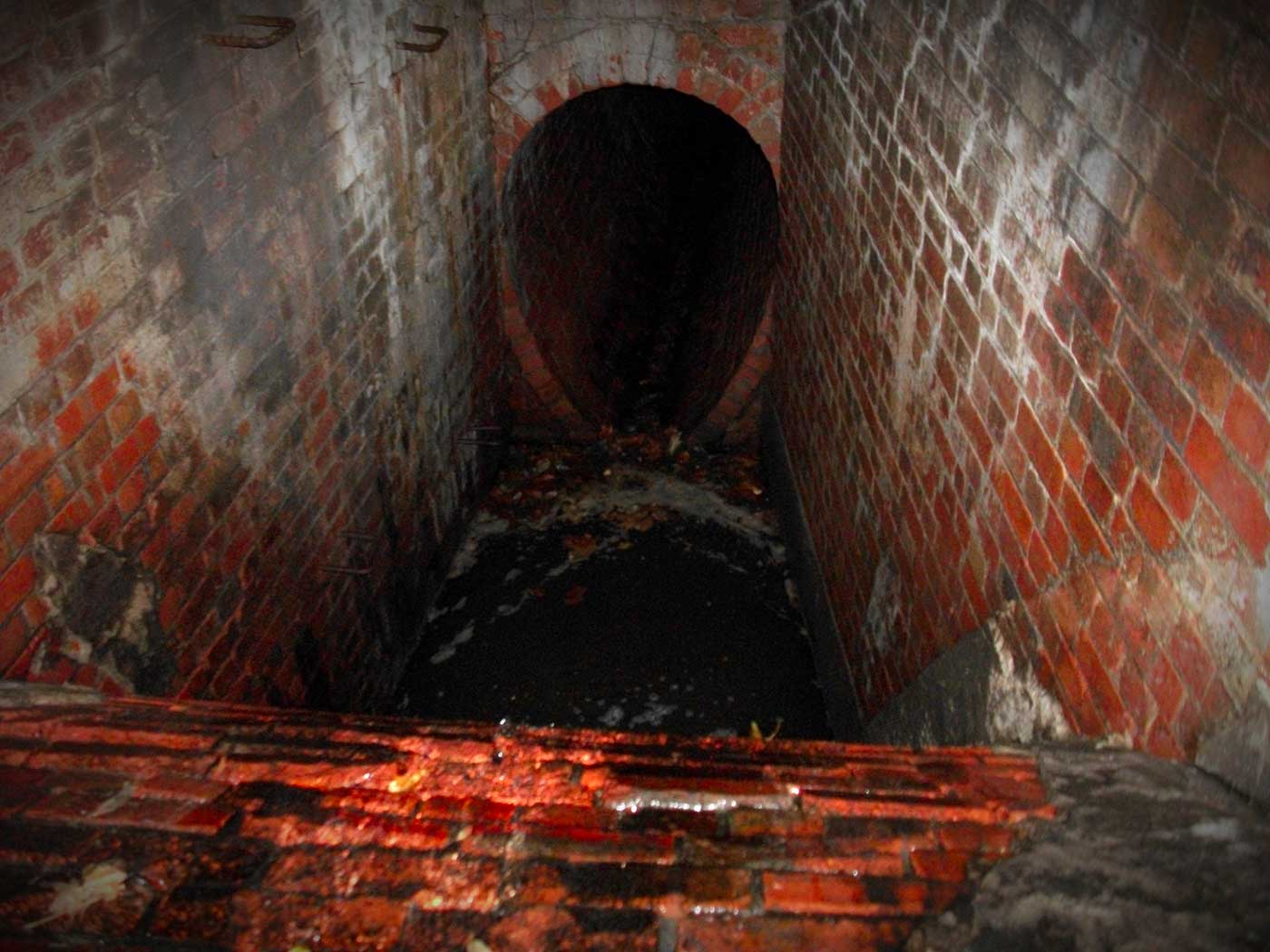
The waterfall had sounded like a crashing maelstrom from a distance; but as we arrived at the lip of the falls, we found it to be little more than a trickle of water amplified beyond recognition by the thick stone walls of the drain. There were rusted iron rungs set into the wall to the left, that led diagonally down across the stagnant water to the far side.
Climbing down was easy enough, save for the minor surprise of finding a huntsman spider asleep on one of the rungs. These are the largest species of spider found in Australia, but mostly docile and more or less harmless. By the time I hopped down onto solid brick at the end, my hands were stained a bright orange by the flaking rust.
From here, the downstream passage seemed to get larger still. When we had both made it down the slippery falls we headed into the brickwork tunnel, and for the first time in hours began to notice signs of graffiti. There were Cave Clan tags here dating back to the 1980s, and it came as a relief to be back in charted territory.
It was around this point we started coming across the larger junctions, too. I think it was ‘Godzilla Point’ that we found first, the name scrawled across the tunnel wall in black aerosol. Up until now, this drain hadn’t felt much like a ‘maze’ – but more a nightmarish hive of deadly insects squeezed into one long and ever-changing tunnel. Now though, we had reached an area where numerous streams began to converge. The path ahead – and behind – fanned out into multiple tubes and passages, as the drain finally began to live up to its name.
Climbing out of a narrow concrete passage, I strode hurriedly through a drift of dead leaves and into the welcoming space ahead. My Swedish friend was still in the last tunnel – a good couple of feet taller than me, he’d be finding these cramped tubes particularly hard going. As I emerged however, there came a sharp hissing sound from somewhere around my ankles.
While spiders don’t usually bother me, I’m not quite so comfortable when it comes to snakes. I don’t know if it’s their size, their fangs, or just the way they move… but falling into a sudden panic I sprang back from the leaves, pressing myself up against the cobwebbed wall behind.
I waited for the sound again, barely able to hear anything over my own heartbeat.

A minute passed in silence, before I dared to creep a little closer to the mound of dead leaves. That’s when I heard the sound again, softer, closer, and realisation dawned on me – with each step I took, drain juice was hissing out through the seams of my waterlogged shoes.
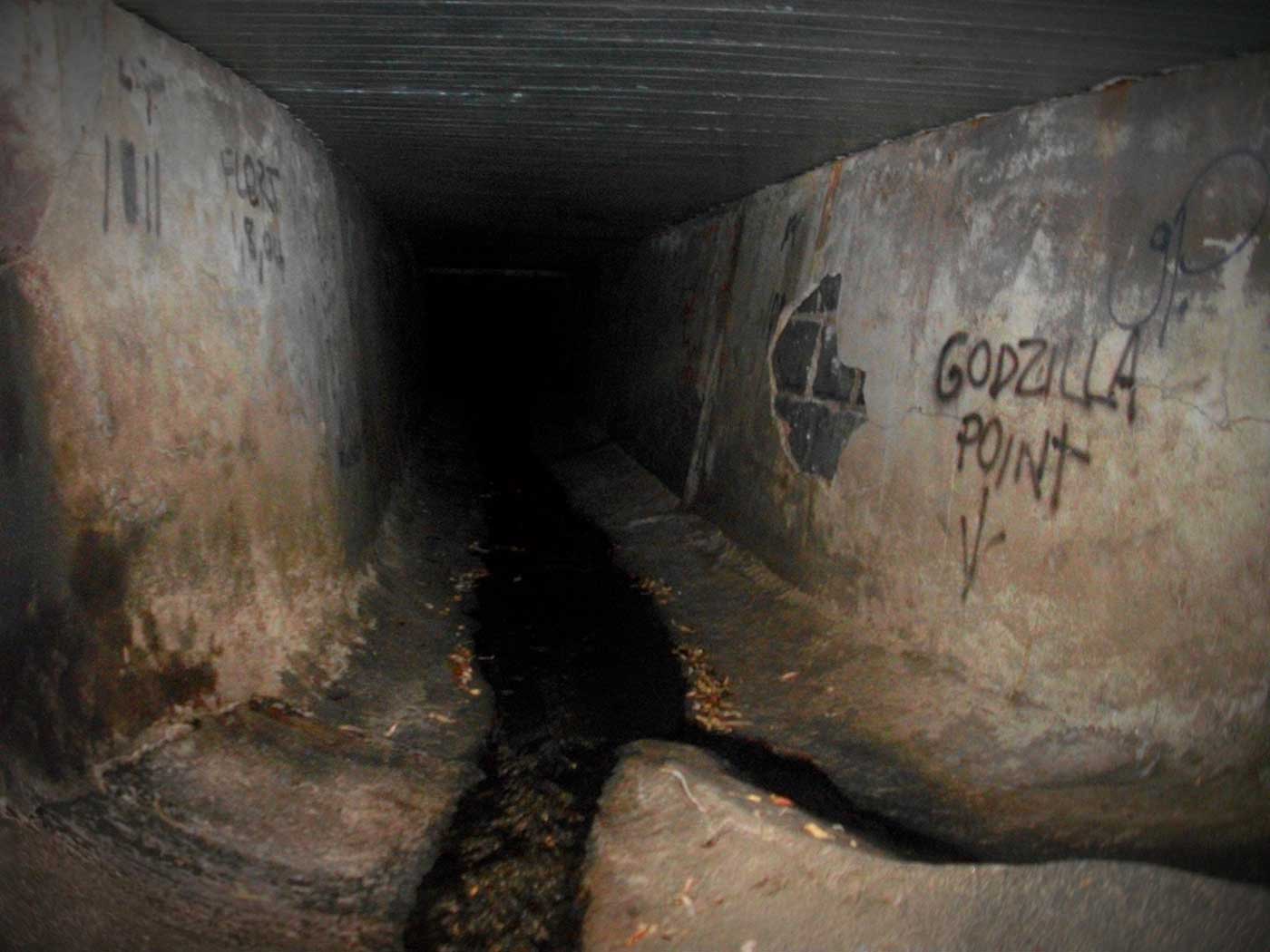
By now, we were both fairly exhausted. We had packed supplies – water, chocolate and suchlike – but these were rapidly depleting after the exertion of the last three hours. With no end in sight, and no idea where we were in relation to the city above, things were starting to look a little worrying. I was beginning to wonder how much nutrition could be had by eating a large huntsman spider.
Ever more desperate, we ploughed on through the drains – through tubes and under arches, sometimes crawling, at other times striding easily through large, open caverns. There were junctions appearing around us with ever increasing frequency, and at times we both wondered if we were following the right path… but we let the water guide us. We’d already seen the large outflow tunnel on the bank of the Yarra, and as long as we followed the course of the stream, the ever-widening brook that babbled along at our feet, we knew we had to be on course.
A little while later we were treated to fresh air. Coming out one corner of a junction we stumbled suddenly into sunlight, the concrete walls here lined with colourful graffiti that shone vibrantly in the light of day. Above us, a metal grate was set firmly in place. There was no chance of budging it, but we contented ourselves by drinking hungrily from the cool breeze that wafted through the bars.
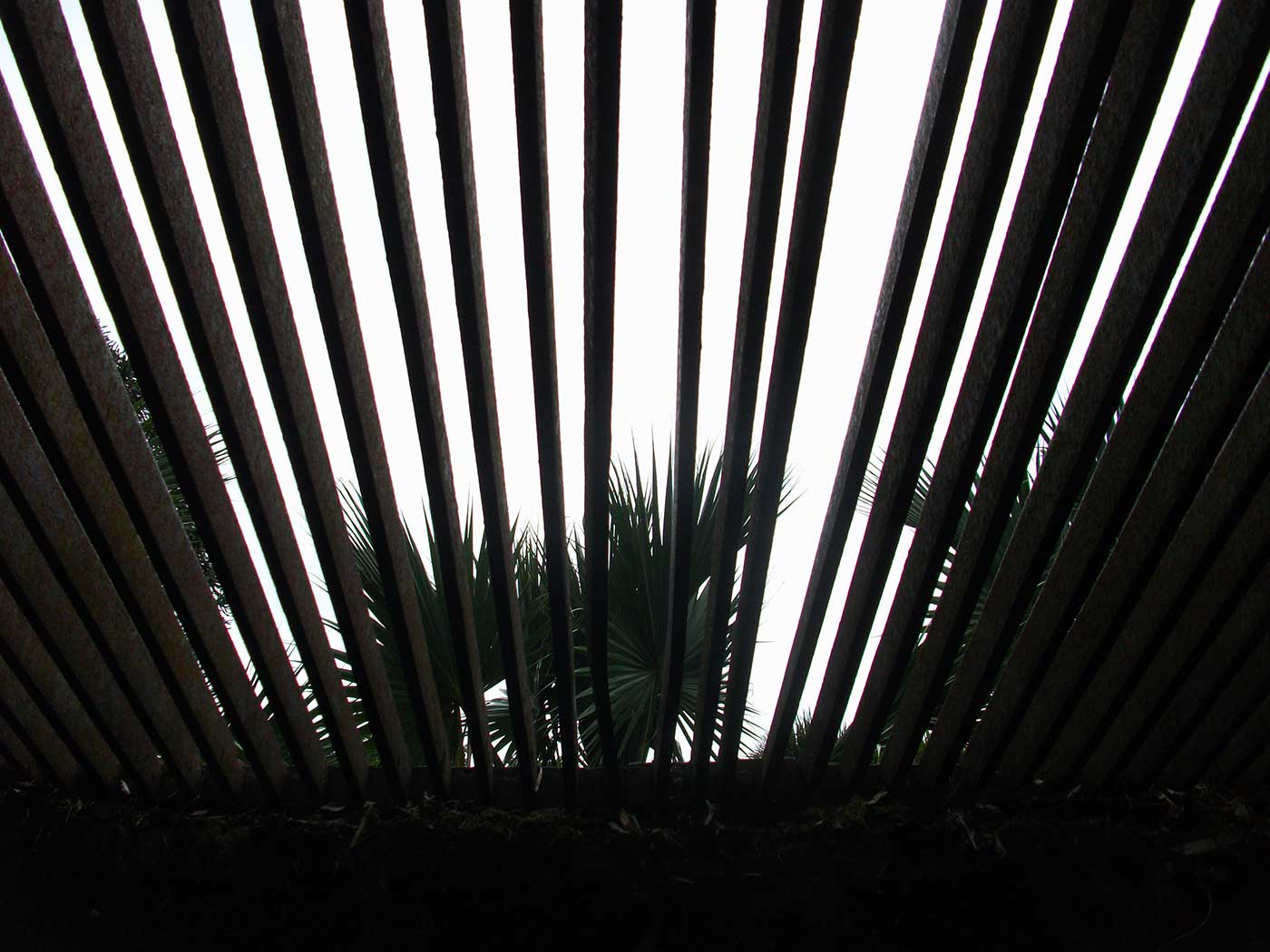
We weren’t out of the maze yet, though; and so after a rest we continued, back into the gloomy tunnels as we followed the stream in the direction of its inevitable conclusion.
The tunnels became larger from here, more spacious, and more colourfully daubed in tags and splashes of graffiti. We began to experience the classic Cave Clan hospitality; little notes were written above side passages, warning of dead-ends or inviting visitors explore further.
It’s a practice I was to see more of in other drains around Melbourne. In many of these networks it would be virtually impossible to get lost, for all the helpful annotations that litter the walls of every passage. The only place I didn’t see it, was back in those upper, seemingly less frequented regions of the Maze Drain.
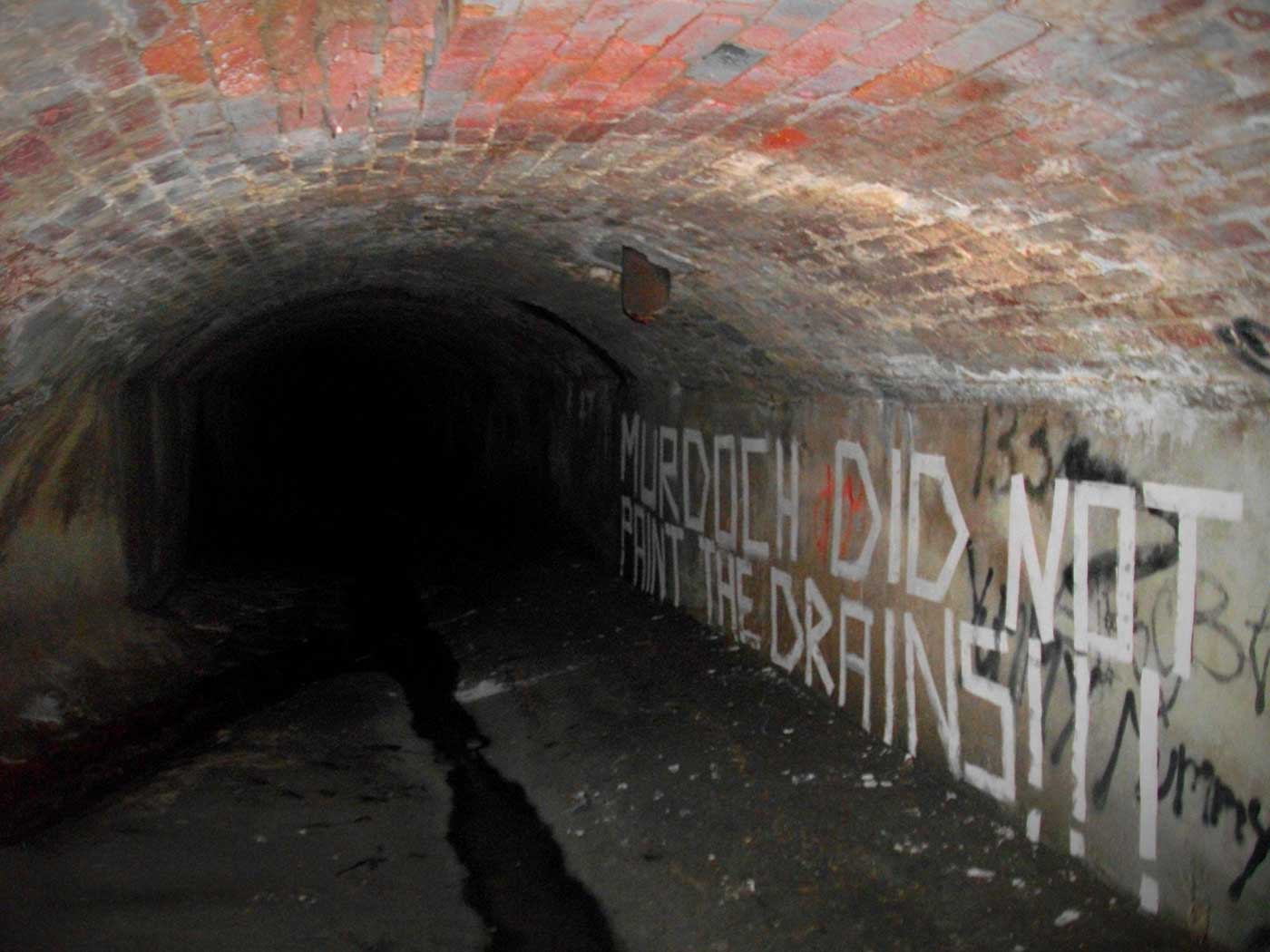
Sometimes the graffiti, rather than guiding intrepid adventurers, poses riddles instead. Here in Maze Drain, we came across one large passage with the words, “MURDOCH DID NOT PAINT THE DRAINS!!!” plastered in tall, white letters across the wall.
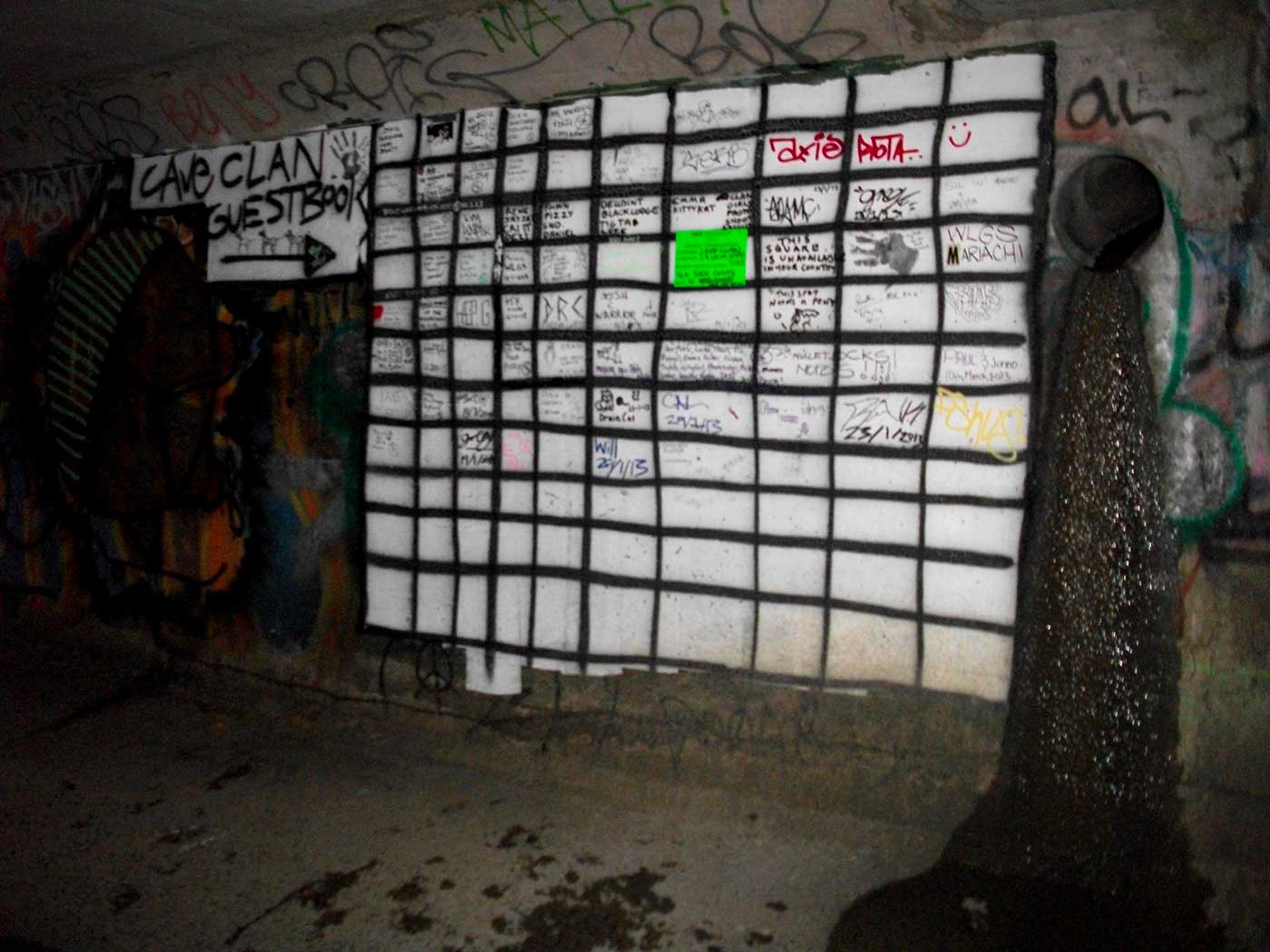
At long last the tunnels spilled into a wide, open clearing. The chamber was divided by a stream, the confluence of many, that filled a central canal running down its length; and lit from one end, where the cavern opened up eventually onto sunlight. Much like the social venue I had found inside the city’s ANZAC Drain, this was the Cave Clan’s local headquarters, the nerve centre of the Maze Drain.
On one wall, taking pride of place in the dingy chamber was the usual guestbook: a whitewashed surface divided up into squares, where plucky adventures could sign their name for posterity.
The two of us scrawled our signatures with pride… we’d done it. From the uppermost culvert to these spacious lower chambers, we’d finally found the way out of the maze.
At this point, we could have got out. The club house opened onto a trench that ran through what appeared to be a park: it would have been easy enough to scale the stone banks, pulling ourselves up and out of the gulley onto the green grass that lay so tantalisingly close beyond. Using that same logic though, I tried persuading my fellow explorer to stay in the drain.

I was eager to see the Maze Drain through to its end – from start to finish, emerging at last on the bank of the River Yarra. I knew that if I simply hopped out here, only three quarters of the way down the route, it would have left me with a nagging sense of dissatisfaction.
After all, what could go wrong? We were so close to freedom now, there was no chance of getting lost. Eventually I managed to persuade him – on the clearly agreed terms that we’d turn back at the first sign of spiders or confined spaces. I was only too happy to go along with those conditions.
Progress from this point onwards was a dream – most of the passages were wide, round tunnels, built to handle an almost unimaginable quantity of rain water. Right now they were dry as a bone, save for a stream running along the middle… and for much of the journey we were able to cover ground fast by running through the drains.
We passed a sign advertising a waterfall ahead, and soon enough we could hear it.

As before, the crashing cacophony of tumbling water was amplified tenfold by the hard tunnel walls – giving the impression of something much larger and more dramatic than the cascading stream we eventually found. Nevertheless, it was an impressively long way down. Perhaps half as tall again as the last waterfall, this time a ladder had been set into the wall beside the stream. We clambered on down the slippery rungs.

After the falls, we passed through the last length of cylindrical tunnel, before stepping down through a large, round outflow pipe and into a vaulted area that flowed directly into the river. We waded into the murky waters.
This cavern led us deeper and deeper through the water – first up to our knees, then our waists, the ground falling gradually away to form the riverbed. Rounding a corner in the tunnel, we saw a light ahead – and then, passing around the last twist in the passage we came upon a distant semicircle of light, reflected in the surface of the river to form a shimmering green oval: the River Yarra itself.
We stood under the arch of the outflow, only a few feet away from the bank where we’d started our expedition so many hours earlier. It felt good to have made it back here.

We decided to try a different route to the nearest exit. Rather than crawl back into the drain from which we had come, climbing the falls and back along the large overflow tunnels to the club house, we took its twin: heading instead into the larger of the two outflows that poured into this final river chamber.
According to my map, the Maze Drain featured a large loop running off from its lower reaches; the open air section adjacent to the club house, which disappeared back beneath the earth, to curve around and eventually spill out here into the river.
As well as routes, the map was marked with a handful of locations: we had seen the ‘Upstream Entrance’ and the ‘Park Entrance’, we’d seen the ‘Pit of Death,’ the ‘Tram Room’ and the ‘Triple Split.’ There were plenty more sites marked though, and some that we were unlikely to reach this time – ‘Dugo’s Dunny’ and the ‘Overflows’ lay a good distance out along one of the tributary streams, while the ‘Slide Drain,’ as appealing as that sounded, was located at the far end of the overflow loop. However, one small cross marked with the words ‘Skull Cave’ had caught my eye; and it lay just around the corner from us now, right beside our closest exit from the drain.
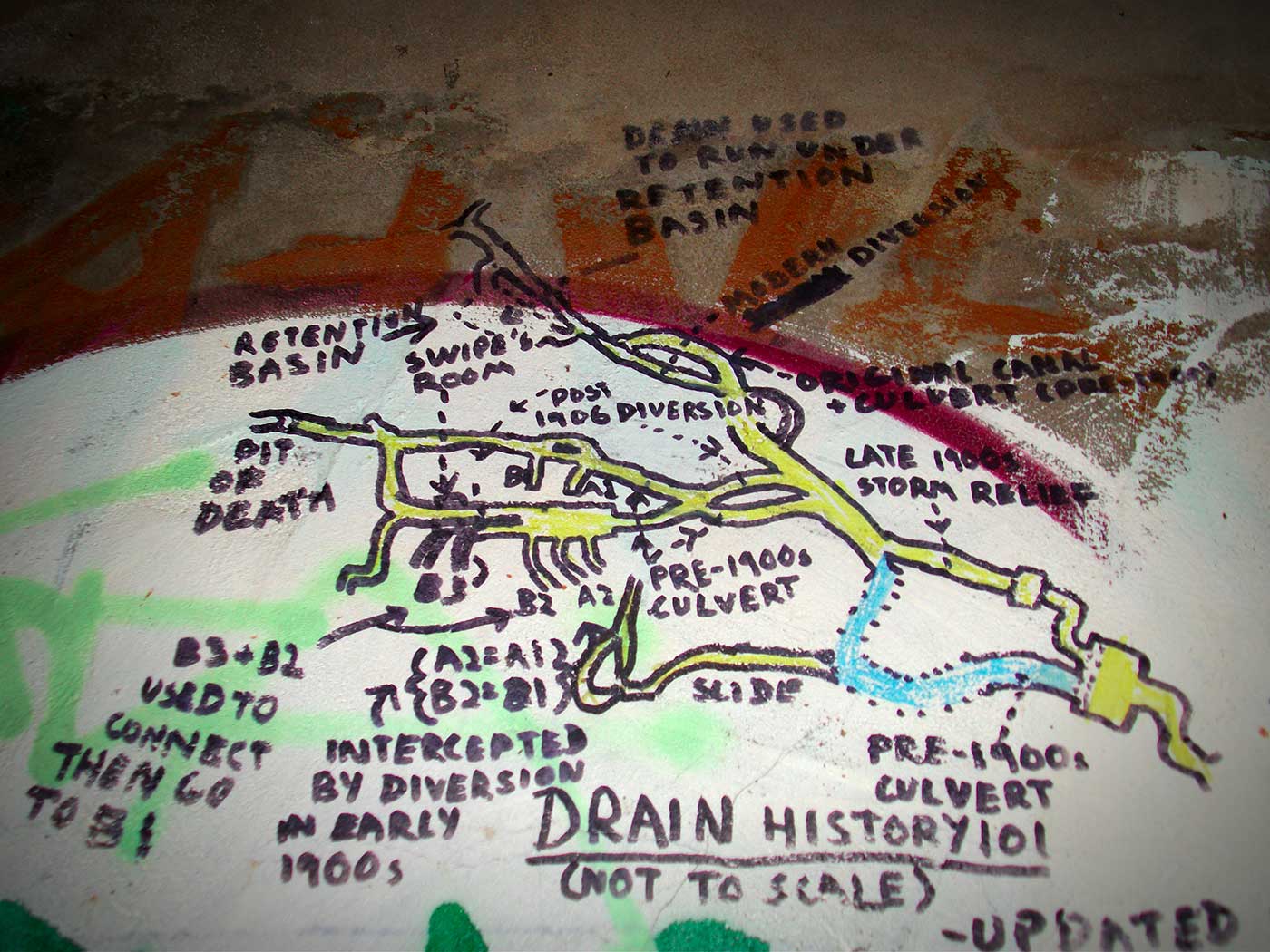
Moving swiftly through these luxuriously large downstream tunnels, we came upon the cave in a matter of minutes… and the Maze Drain enjoyed one last laugh at my expense.
The opening on the wall was shaped like a skull, and hard to miss. I tried clambering up there, getting a hold on the slippery bricks as I pulled myself up level with the brow. I really wish I hadn’t bothered. Through the opening, I could just about make out a dim chamber beyond… but before I could take it in I’d been hit by a powerful wall of pungent air.
While most of the Maze Drain is washed by freshwater (stale, airless water, but once fresh, nonetheless), the cave ahead was a true sewer. I was nearly knocked over backwards by the strong aroma of excrement and I quickly made for the stream, doing my very best to wash the sticky, dark residue off my hands.
Our journey was at an end, though. After the Skull Cave the tunnel broke out into the open air, a tree-shaded canal bed hidden behind the garden fences of suburban terraced houses. Climbing up the bank, we were able to squeeze through a gap in the fence, coming out onto a quiet footpath. We rounded the corner and found ourselves right back at the train station: the very place we’d met, all those seven long hours earlier.
I’m sure there’s probably meant to be a moral to this story. Did I learn anything from my experiences though? Absolutely not.
Three hours later I was out on the other side of the city, past the freeway, wading through a marsh in the darkness as I searched for an entrance to the “God Drain.”


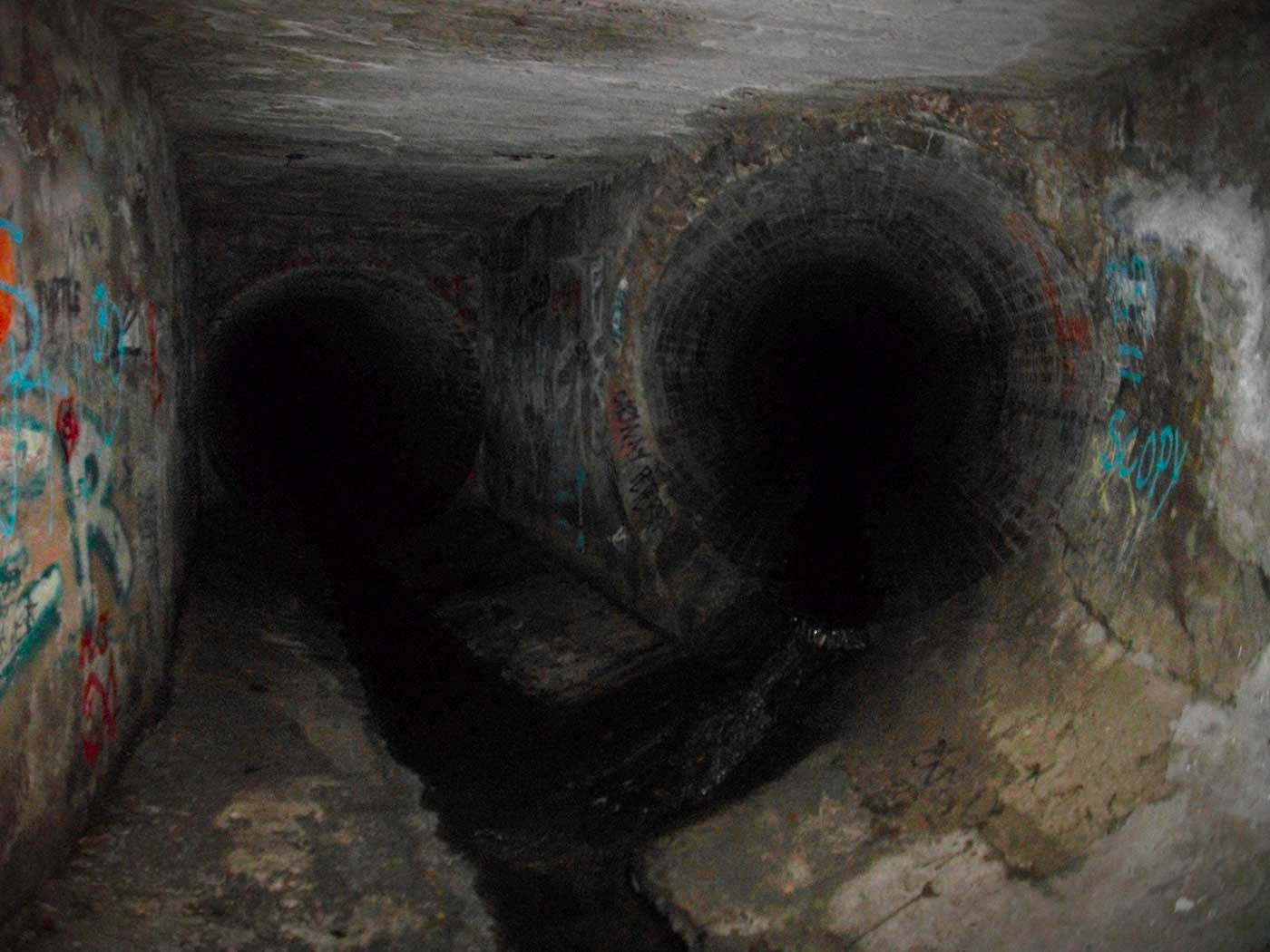


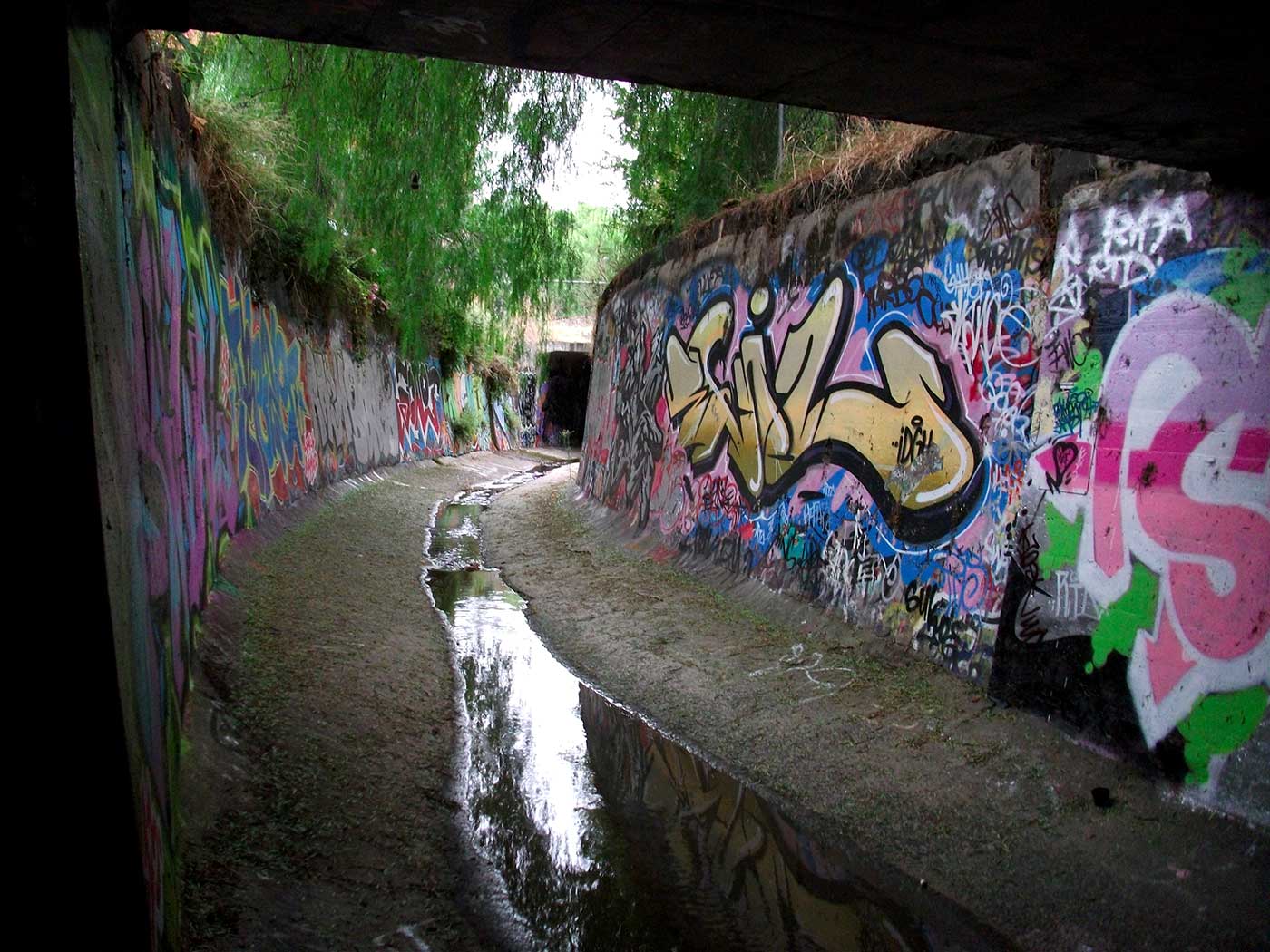



Comments are closed.
See all 45 comments on “Flashlights and Spider Bites in Melbourne’s Maze Drain”

An illustrated guide to urban exploration in the Russian capital.

Poltergeists, ritual murder & a live-in succubus – the 1000-year-old pub with a ghostly reputation

A month-long monument hunt, and what I learned along the way.
My buddies and I used to grab pizza and beers and head down to the open drains near Glenferrie to paint way back in 2004, good times.
Great story, the spiders make it an instant “nope” for me, crazy.
Billboards nightclub has an entry inside the building or very close to it
I’m 50 now and I used to love exploring the drains when I was a kid in Melbourne.
I’m going to take a wild guess and say there’s an entrance near Toorak station, obviously one of the entrance pics shows either a foot bridge or rail bridge near it…..pretty much like there is near Toorak station. But I could be wrong.i might be getting to old for this shit but it’s something I’ve never done and always wanted to so when the weather warms up I might go exploring. I know there’s a stand up sized entrance in Blackburn so might start with that and see where it leads me because well it’s like a 5 min walk from home….lol
The main entrance is in hawthorn
Ah, this takes me back. I’m too old for these sorts of shenanigans now, but it’s nice to see it all again. Many thanks.
Where is the entrance to the tunnels near yarra river? I’ve wanted to do it but not sure where it is. I’ve seen a vague map of where it is in the city
A park that starts with the letter “G” near Hawthorn/ Glen Ferrie station. Good luck
Hey,
I am a mid teen who has done some smaller drains before in the suburbs and now i want to do some bigger ones in the city. I just have no idea on where any entrances to the drain is and as the holidays are coming up i would like to do this drain. Could anyone tell me the location or how to find out the location?
There is an entrance to the maze drain in Grace park Hawthorn
There are easier ways to get into the Maze, the retarding basin entry is considered the hardcore entry/exit. I have been it a few times and it does see a lot of traffic in the Summer months. Someone from the Cave Clan wrote to Melbourne Water complaining that the waterfall did not have a ladder and they put one in.
Do you know where the entrance near yarra river is?
I’ve read this post a few times. It always makes me want to revisit The Maze 🙂
Great job.
Cheers, Doug. Skimming through now makes me want to revisit, too! Maybe I’ll make the trip back one of these days. 🙂
Fuf, so intersting places. I’ve visited some places like this in my city ))
It’s amazing how much hidden stuff there is beneath our feet.
I think we’ve been using the same Google maps map. I was sent it from the guy who created it. This is a map of the drain here http://www.uer.ca/urbanadventure/www.urbanadventure.org/members/drains/uacity/maze/m-maze.jpg
Interesting! Yeah, maybe we have… it certainly helped out on my trip, I managed to get round 12 drains in just a couple of weeks!
Awesome I used to crawl up under houses in Florida doing pest control ..i hate spiderzzzzz
you should come to buffalo NY and see the central terminal
Absolutely! I’ve seen a few pictures of central terminal, it looks fantastic! And I apologise if this post brought back any bad memories of claustrophobia and spiders…
Hey! Great report. I know this drain back to front. The path you took from upstream is my favourite by far.
Murdoch is an explorer. The tag’s sarcastic, probably written himself.
If you want to see some of the more exciting branches of it, I can take you on a safer tour. It’s an /amazing/ drain, man!
Hey Leo, cheers for the comment!
Really is an awesome drain, isn’t it? From looking at a few maps later on, I get the impression I only saw a fraction of the network there. I’d absolutely love to take you up on that tour, next time I’m in the area!
Yeah, definitely! There’s a whole southern branch equal in size to that one. The slide drain is pretty great, too. And depending on your height limits, some of the sidepipes are pretty extensive in and of themself – and certainly have some very interesting and unexpected exits!
I saw ‘Slide Drain’ written on a map, and thought it sounded like a lot of fun… is it as messy as the name suggests? I found a drain like that in Bulgaria not long ago. Absolutely disgusting, ended up caked in filth, but it was the most fun I’d had in ages.
Yeah, sounds like I definitely need to give Maze another go sometime.
This was a sarcastic coment and true. I can tell you that i didn’t write this in the maze.
Haha, nice. The man himself! Cheers for clearing that up…
Hey mate, great post. I’ve been in this drain and I didn’t see any spiders, but I was deliberately not looking and making sure not to touch the walls. I’m definitely glad I read this post AFTER being in there!
Also you can find more of Murdoch’s adventures here: http://www.flickr.com/photos/murdoch80
Ha! And there I was, trying to find some kind of historical basis for the graffiti…
Cheers for checking out this post. I didn’t think the spiders were too bad in most parts of the drain, I just have a habit of going looking for them. That first passage though… that was plain nasty.
I just stumbled across this and was totally pulled in. It was so great I was reading it out loud to my husband as we were driving down the road. Wonderful writing it kept my attention with the occasional shutter(spiders are one of my biggest fears). This was an awesome adventure. I now consider myself a fan. Thank you from a girl in Kansas.
That’s amazing – very high praise indeed, thanks!
Thank you for commenting, and great to have you onboard.
What became of your spider bite? My skin is crawling from your description of that first tunnel!
Good! I’m glad I was able to convey at least a little bit of the sheer terror I felt while I was in there. 🙂
The area around the bite was a little purple and puffy for the next few days. More numb, than actually painful. After about a week or so it had disappeared completely.
Ah, great. And you want me to go drain exploring with you?
I’m glad we’re not going to anywhere exotic.
You never know, we might meet a badger – they’re pretty ferocious things.
This was truly wonderful to read. From one urbexer to another, I thank you for this awesome piece.
Thanks, that means a lot! I’ve just been having a look through some of your shots actually, over on your facebook page – you’ve got some great locations there.
I learned how good Beer tastes after spending several hours inside a massive drain 😉
Really awesome writing!
Ah, the man himself! Glad you enjoyed the write-up, and I hope it didn’t bring back too many painful memories for you.
Not at all! Was really enjoyable to read! even though the adrenalin started pumping at some Points 😉
That was a great read, even with all the spiders.
Thank you, glad you enjoyed this one! It was a bit longer than most of my posts, but I felt it was a story that needed telling…